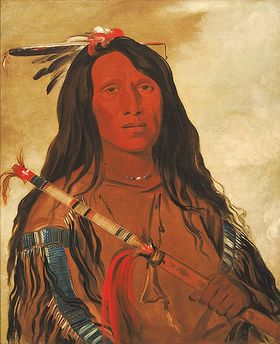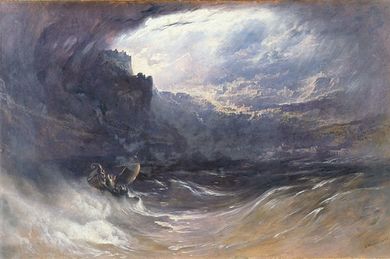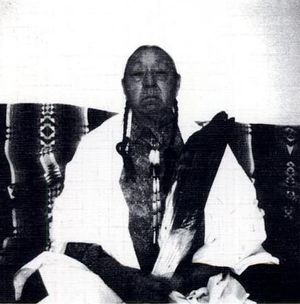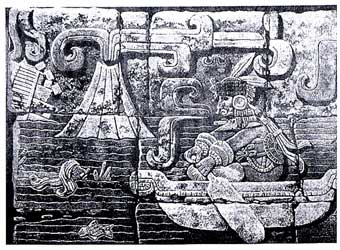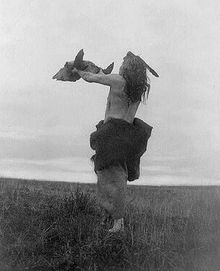The birth of Venus out of Orion (II)
In general a student of North American Indian cultures must get the impression from ethnographic literature, that these cultures are very recent, carried to the extreme, that they basically emerged at the time of the coming of the white men. But while studying Cheyenne/Tsistsistas culture, I was very impressed about the detailed knowledge they keep about their remote past. The Cheyenne sacred episodes are comparable to the Gilgamesh Epic or the legend of King Arthur (Moore 1987: 89,102,105,121,122,321), and it is quite sure, that not all of it is told yet. This sacred knowledge is handed down among the Arrow Men during their ceremonies and certainly is not shared with anybody just coming along to ask some questions. A special relationship is needed which builds up over years. In addition, "one has to keep in mind, that a lot of what has been written about the Cheyenne in anthroplogical literature is incompetent and wrong. Often published mistakes are further cemented in later publications, because ethnologists tend to write off from eachother, instead of asking new questions directly to the group with whom they are concerned" (Schlesier 1985: 154). Most likely, this is also the case for the other Indian tribes and their representation in literature.
Often arguments are raised against the value of oral history compared to written history. To me it almost seems to be the other way around. What is written down tends to be forgotten by the people and confusion starts, resulting in misinterpretation or other inventions throughout the millennia. Whereas the memory in oral cultures stays alive and almost pure, while being handed down through the generations. The history of the Cheyenne about their ancient past and the settlement of the North American continent for example contains more detailed information than any of the theories science came up with so far:
First the red men lived in the high north (Asia) in the beginning, in constant spring. They shared the land with two other races, the hairy men, who had hair all over, and the bearded men. The hairy men left for the south land (America) first, followed by the red men later on. The land was dry and barren. There the hairy men lived in caves high up in the mountains. They were seen by the red men only seldom. When the red men went to visit, the hairy men were frightened and moved back into their caves. There they had beds from leaves and fur, and they possessed the same stone tools, cups and plates like the red men. The hairy men did not increase. They became lesser in number, until they totally disappeared.Today the Cheyenne don't know anymore what became of them.
When they were in the south land a flood catastrophy happened, which was limited to the South Land and which forced them to go back to the North Land. All this happened a long time ago when men was created. After some time the red men went back to the South again. The waters had disappeared, grass and trees had grown. Now the land was as beautiful as the North Land. But a second flood came, mightier than the one before, which destroyed almost everything. They went back to the North Land, just to find everything destroyed the same way.
Many hundreds years later the red men moved back to the South Land again. That's when the earth shook and the mountains blew out fire and smoke. There were floods again and the Winter (ice age) began. The red people dressed in furs and lived in caves. The Winter was long and cold. It came a phase of gigantism, when people and animals were real huge. It was in this phase of gigantism that the Proto-Tsistsistas received the four sacred Arrows from Motseyoef / Venus. "The people went on and Motseyoef/Venus was leading them. When they arrived at the mountain Bear Butte, a single arrow tumbled down from the sky. They tried to pull it out from the ground, but they couldn't, because it was a man" (Motseyoef). In another story a girl marries a bright star and falls down to earth pregnant with a boy. Although the fall kills her, her unborn child did not die; because he was made of stone. The Arrow Keeper (Fig. G) pointed out, that this stone was Motseyoef, who is also called Stone or Falling Star.
Motseyoef grew for a long time. As a boy he performed miraculous deeds, like feeding all the people during the Winter. He was very intelligent and powerful. One day he got involved with an old man over a buffalo hide. He struck the old man over the head with a leg bone and left him lying there. When the men of the tribe chased him, Motseyoef escaped. He ran over five ridges, each time reappearing a a different dress of the later formed warrior societies. From there on he was not seen for four years.
Maheo (God) guided him to the holy mountain. Here the spiritual beings taught him all the ways of Tsistsistas life, tribal government, and the religious ceremonials they still have up to this day. Here he got the four sacred Arrows to give to the Tsistsistas. Before he returned to them, the first Arrow Renewal was performed on the sacred mountain, in early spring when life begins. The purpose of the Arrow ceremony is to renew life, to give guidance to a new life after death and purification of all Tsistsistas, to renew faith and start anew. [1]
Motseyoef lived with the Tsistsistas 445 winters. Every winter he would get older, springtime he would get younger again. During that time he taught them everything, all the rules and laws they were going to live by. Then he felt his time was up. That same day a terrible storm came up, it thundered and lighthning flashed. The skies grew very dark and the earth trembled. The people knew it was in account of him. When Motseyoef left the Tsistsistas, he transformed into the Morning Star. With new floods spring came back and new growth. From there on there were no more floods and no starvation. The red people stayed in America. They multiplied and developed into the different tribes with different languages. People became strong in mind. (Schlesier 1985: 96, Schukies 1993: 34-44, 191-203)
An ejected or twirled off "water cloud" from Planet Jupiter, or Saturn, could have traveled through space and hit earth in form of torrential rains, walls of water and floods. On earth this big flood near the beginning (the non-cultural time of the Golden Age) was not connected to a particular planet by the people. Probably they were living happily beneath the stars, just admiring their beauty, before the catastrophies happened. As they lived in constant spring, this means the tilt of the planet's axis was different from today. Then a water cloud might have hit the earth in two waves, a smaller one, which hit mainly North America and South America. Then shortly after that a second wave inundated the whole earth, and was remembered as the deluge.
Then, only many hundred years later the earth was shaking, mountains were raising and crashing, blowing out fire and smoke, accompanied by floods. The earth axis tilted. The water froze in the beginning ice age, the phase of gigantism. The comet must have come closer and the red star appeared in the constellation Orion. It took a long time for him to grow bigger in the sky. For 445 years comet Venus might have been orbiting through our solar system. Then Venus "crashed" with Mars, which flipped planet Venus to its new orbit around the sun. Venus became the new second sun, the Morning and the Evening Star. The earth and the heavens calmed down. It enlightened throughout the world, "cultural time" began. Star priests started to observe the movements of the stars and the sky on a regular basis.
Velikovsky was the first one to state that North American Indian cultures are much older than it was generally thought. This insight is certainly shared by the Indians themselves. The Cheyenne date the birth of Motseyoef / Venus back to "two or three thousand years ago" (Dorsey 1905). Karl Schlesier, not knowing the thesis of Velikovsky, concluded from his own research that Cheyenne culture, as we know it today, came into being about 500 BC (Schlesier 1985: 154). In personal communication he sets the date even further back, to about 1000 BC. This fits perfectly well with the Achsenzeit of Karl Japers, 800 BC to 200 BC. During the Achsenzeit it enlightens for the first time, this structuring all of the following developments. In Greece, Palestine, Iran, India or China, simultanious breakthroughs in thinking are happening. Independent developments result into a first historical epoch of enlightenment the fundamental basis for all later developments. (Roetz 1989: 38-44). These breakthroughs obviously also happened in the Americas at the same time. In his thesis Roetz mentiones Velikovsky's theory as a possible explanation. The analyses of the rock art in Valcamonica, North Italy shows, that at a certain point in time abstraction begins and the few important signs, out of hundreds of thousands, basically do not change way up into the Romanic times (19 BC), when alphabetical writing was added to them. In conventional dating the "development" of this abstract period is streched over 5000 years. (Sanders 1983:46) But it is quite obvious that a time span of 600 years is more than enough for this kind of development. This rock art has to be dated to the Achsenzeit, 800-200 BC.
Also the Cree (Fig. J) tell that they were not the earliest inhabitants but that they had displaced an earlier and autochthonous race, the ancient people, also called hairy-heart beings. They were physically hairy, and dressed only in animal skin breechcloths. To illustrate the look of the ancients the anthropologist was shown the conventional illustration of Neanderthal man. This conception of the ancients or hairy hearts is shared with other Algonquian groups, to whom also the Cheyenne belong. (Brightman 1990: 108-128) But it has to be noticed that the Cheyenne description of the hairy men differs in certain aspects from the versions which are presented by Brightman. The story of the hairy men and the red men living at the same time on the American continent, strongly reminds of the latest discoveries in palaontology, Neanderthals and Cro-Magnon, anatomically modern men, living side by side in the Near East, sharing the same material culture, the same way of life over a period of 60,000 years. And also for science it is basically still a riddle why and how the Neanderthals disappeared (Bar-Yosef & Vandermeersch 1993: 32-39) In 1976 Ernst Hoening discovered probably one of the most important sites of paleontology, Stone Creek in Alberta, Canada. The datings of artifacts and bone fragments found there, suggest that Neanderthals lived in America about 100,000 years ago. So far there has been no official excavation of this site, the results being ignored by mainstream paleontology in Germany, Canada and the US (Hoening 1981). Proposed theories, which declare Homo sapiens to be the mutated offspring of Neanderthals, triggered by the cosmic collision are therefore heading into the wrong direction.
Throughout the Plains astronomically related structures in form of a wheel (Fig. I) [2] are found. The two most impressiv ones, Big Horn and Moose Mountain, have been investigated by Grinnell (1922) and Eddy (1974, 1977, 1981). About the Big Horn Wheel, the astronomer John Eddy noticed, that the 28 spikes of the wheel correspond to the number of days of the mooncycle, and that the placement of 6 small stonecircles on the outer circumference could be related to astronomical phenomena. Three of these circles were placed in correspondence to Aldebaran in Taurus, Rigel in Orion, and Sirius in Canis Major at the time of the summer solstice. The Big Horn wheel was dated to the 17th century. Also at Moose-Mountain these stonecircles were placed in correspondence to the position of Aldebaran, Rigel and Sirius. Here Eddys calculations suggested a date of 100 to 500 A.D. When asked about the Moose Mountain medicine wheel, local Indians reported, that it had been made by people who had no iron. Radiocarbon dating of charcoal by the archeologist couple Kehoe gave an age of 2650 (+- 245) years, which again covers the period of the Achsenzeit. Strangely enough, Eddy published a beautiful photograph of Planet Venus rising behind one cairn, but doesn't comment on it in his analysis (Eddy 1974: 1035-1042).
There are different speculations as to what purpose these wheels were constructed for. Grinell supposed that the Big Horn wheel could be the diagram of the Tsistsistas New Life Lodge (mistakenly called Sun Dance). Schlesier connects the Big Horn wheel, as well as Moose Mountain, to the Tistsistas Massaum ceremony. The Massaum was given by Motseyoef / Venus and it was also called an Animal Dance, Crazy Dance, or Foolish Dance. A healing ceremony was part of it. The Massaum is the lodge of the Contraries (hohnuhka), who carry the lightning bow, the original weapon of Motseyoef / Venus. The Massaum was performed after the Blue Sky Tipi, the Arrow Ceremony and the New Life Lodge. According to Schlesier the Massaum was performed each year in the middle of an old ceremonial period, and concentrated on the blue star Rigel in Orion.
According to Schlesier in those early times the ceremonial cycle of the Tsistsistas consisted of two times 28 days. It started with the rising of the red star, Aldebaran, and ended with the rising of the white star, Sirius. In the New Life Lodge these stars are of no importance. The Massaum Lodge was constructed in a circle of 28 poles, with a tree in the middle. It lasted five days and had five main actors. The central tent of the Massaum was called Wolf Tipi and belonged to two wolfes: a red male wolf and a white female wolf, the horned wolf. The third animal of the Wolf Tipi was the yellow kit-fox, Voh'kis. According to Schlesier Voh'kis is the manifestation of the blue star Rigel in Orion. The symbol of the blue star was painted in form of the German Iron Cross} / Maltese Cross on a buffalo skull during the Massaum ceremony. (Schlesier 1985: 117-125) But according to Grinnell this German Iron Cross represents the Morning Star / Venus (Grinnell 1923/1972: 305). As Vo is the Tsistsistas word for the planet Venus, it is highly likely that the word Voh'kis is connected to Venus, too. A kit-fox skin is also the cover for the four sacred Arrows (nimahenan, mahuts) representing Motseyoef / Venus.
Schlesier supposes that the Cheyenne had a Star Keeper, comparable to the Blue Sky Keeper, in the old times. So it is not quite understandable that in his opinion these wheels were not constructed for observational purposes. But considering their place on top of mountainpeaks, it seems quite likely that these wheels have indeed been contructed to observe the movement of the stars and planets. If elements of the wheel structure correspond with ritual elements, it just strengthens the argument that ritual, myth and astronomy are inseparably connected. An old informant related that the Cheyenne had known the stars and the names of the different pictures, but had disregarded that knowledge until it was gradually forgotten (Petter 1913-15:1009). What starts shining through, though, is a connection between the constellation Orion and planet Venus.
Continuation
- back to: The birth of Venus out of Orion (I)
Footnotes:
- ↑ Editorial remark: "In the Arrow Renewal, various bands of extended families came together for a four-day ceremony. Three ceremonial lodges were placed in the center of a circle of tepees: the Sacred Arrow Lodge, the Sacred Arrow Keeper’s Lodge, and the Offering Lodge. Men performed various rituals in and among the lodges to renew the Sacred Arrows and the spirit of the tribe. The four sacred arrows were often carried into battle by a chosen warrior, bound to the stem of his lance." (source)
- ↑ Editorial remark: cp. William R. Corliss, "A Different Way Of Looking At The Universe" (1984), Science Frontiers Online
Illustration
- G) Renate Schukies, "Red Hat: Cheyenne Blue Sky Maker and Keeper of the Sacred Arrows", LIT Verlag Münster, 1993 (image processing by Atlantidforschung.de)
- H) Tony O’Connell, "Maler, Teobert", bei: Atlantipedia.ie
- J) Bela Hubbard, "Ancient Garden Beds of Michigan", in: American Antiquarian, 1:1, 1878; Reprinted in: INFO Journal, 12:6, no. 2, 1989 (INFO = International Fortean Organization, P.O. Box 367, Arlington, VA, 22210); via: William R. Corliss, "Michigan's prehistoric garden beds" (Science Frontiers Online)
- K) Wikimedia Commons: File:Mandan hunter with buffalo skull.jpg (image processing by Atlantidforschung.de)
